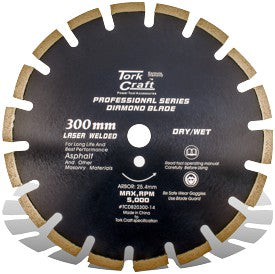

TYPE:
Laser weld and segmented
DIAMETER: Ø 300mm
BORE: Ø25.4mm
MAX RPM: 5,000
USE: Asphalt
What is a diamond blade?
A diamond blade is composed of a circular steel core and the diamond impregnated segments. The segments are seperated by slots in the core.
These slots assist in cooling the blade during operation by allowing water (wet cutting) or air (dry cutting) to flow between the segments. The segments or rims are a mixture of diamond powder and metal powders. The diamonds are industrial diamonds of different sizes and qualities depending on the material to be cut as well a the blade type.
How does a diamond blade work?
 The individual diamond crystals exposed on the leading edge and the sides of
the segment or rim carry out the cutting. The operator pushes the rotating blade
into the material and the surface diamonds thus exposed mill a groove in the
material. When the blade mills the material, the latter exerts wear on the
blade. During cutting the exposed diamonds may crack
or break. The material simultaneously starts to abrade the metal matrix, which
releases more diamonds.
The individual diamond crystals exposed on the leading edge and the sides of
the segment or rim carry out the cutting. The operator pushes the rotating blade
into the material and the surface diamonds thus exposed mill a groove in the
material. When the blade mills the material, the latter exerts wear on the
blade. During cutting the exposed diamonds may crack
or break. The material simultaneously starts to abrade the metal matrix, which
releases more diamonds.
 The more abrasive the material, the more rapid
the tendency to wear down the matrix. Blades for cutting hard, denseless
abrasive materials (such as tile, bricks, stone or cured concrete), require
a softer metal matrix.
The more abrasive the material, the more rapid
the tendency to wear down the matrix. Blades for cutting hard, denseless
abrasive materials (such as tile, bricks, stone or cured concrete), require
a softer metal matrix.
This will wear down faster, replacing the worn diamonds fairly quickly so that the blade continues to cut.
Blades for cutting soft, abrasive materials (such as green concrete and asphalt), must have a hard, abrasion-resistant metal matrix in order to retain the diamonds for a longer time.
Water will prevent the blade from overheating:
It will greatly reduce the amount of harmful dust created by cutting. Remove the
slurry from the cut, and extend the life of the blade.
Different methods of making diamond blades:
Laser welding:
Laser micro-fusion enables the segment to be welded to the core. This bond is the most powerful and enables the tool to be used for dry cutting and drilling without segment loss.
Brazing:
Silver brazing solder melts at high temperaturs between the segment and the core and binds the two elements together. Used for wet cutting, drilling and grinding.
Cold sintering:
First pressed with a press machine under normal conditions, then laid in sinter machine under high pressure and temperatures making the compressed metal powder melt to a solid bond.
Hot pressed sintering:
Pressed with hot press machine under high temperature and pressure, making the compressed metal powder melt to a solid bond.
Blade types:
Continuous smooth rim:
Provides the smoothest cut in ceramic tiles and ornamental stones.
Turbo/Segmented Turbo:
May produce slight chipping, but generally have a longer life and lower cost per cut than continous rim blades.
Segmented:
Provide the longest life and lowest cost per cut, but are only suitable for work where chipping is not a problem.
When cutting without water:
The blade should be allowed to cool off periodically. Cooling can be increased
by allowing the blade to spin freely out of the cut.
| consider safety for your health and the people around you | |||
General safety suggestions:It is advisable to always have the following items nearby and in a good condition
|
|||
|
|
|
|
|
|
Wear Gloves
|
Eye Protection
|
Hearing Protection
|
Dust Mask
|
CAUTION:
Diamond blades are unable to withstand the forces involved at elevated
temperatures when cutting dry. It will be subject to rapid tool wear and
possible failure.



